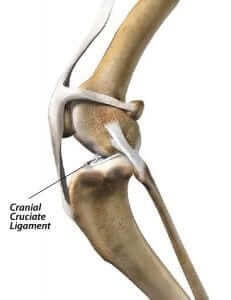Lameness and discomfort are very common in our canine companions, especially as they get older, but a cruciate ligament injury often tops the list. Cruciate injuries are not specific to the older dog, but more common in any aged pet, especially if they are large breed and active. Given the high prevalence of these types of injuries, the expense and inconvenience behind cage resting, we have to dig deeper to determine possible contributors and how proper supplementation could be implemented to improve the odds of a full recovery.

A canine cruciate ligament injury is very common, becoming more prevalent over the past 10 or more years. These injuries are not just specific to dogs, but also occur very often in people. The knee or otherwise known as the stifle in pets, is very similar to our own knee with a few exceptions. The knee is the junction of three major bones; the femur, tibia and patella (kneecap). There are two cruciate ligaments within the joint, cranial (anterior) and caudal (posterior), with the sole goal of stabilizing the knee joint and preventing excessive forward or backward movement. In addition to these two structures, there is also the meniscus, which is a cartilage-like cushion present on the joint surface of the tibia. There are also outside and inside collateral ligaments which stabilize the joint from bending either direction to the side. All in all, it is a solid joint, designed to flow smoothly with movement.
So, how does a canine cruciate injury occur?
Most cruciate ligament injuries occur due to excessive forward movement of the joint, leading to a partial or complete tear of the cranial cruciate ligament. This most often occurs as the pet is running, then plants their rear feet solid, but yet the upper body continues to accelerate forward. This also occurs in human athletes. If the lower body is locked in place, from knee down, but yet the upper body continues to accelerate, it will result in excessive forward motion in the knee joint, tearing ligaments and often the meniscus. 
The interesting thing to me is that as much as we can picture this physical event taking place and the damage that ensues, we have to also step back and look at the overall prevalence of these conditions. They are on the rise! Does this mean that more dogs are playing frisbee? Not necessarily, as they are also happening more often in small breed dogs that are indoors or in older pets that are inactive. If we look at ourselves, we also note that the incidence in people is increasing. I remember in high school, many years ago, seeing a classmate here and there with a knee brace on, but in recent times, it is more common to see 2 or more student athletes with braces and histories of surgery. Why?
There are many factors at play, not just physical. It is true that many pets and people are actually putting more effort into their sports, potentially beyond that which the body was designed to handle, but there is more. To me, I look at diet and see if there is a connection with prevalence, to which there appears to be one on a crude level. More pets are on highly processed, commercial feeds and more student athletes are hooked on caffeinated drinks and often fast food. This raises the question of whether adequate protection is provided for to the body. We will get to this later and how to manage.
Clinical Signs of a Canine Cruciate Ligament Injury
The majority of pets with cruciate injuries present with what is termed a ‘toe touching’ lameness, meaning that they will walk, but will only put light weight on the toes of the affected limb, quickly shifting weight to the other leg as the ambulate. It is not something hard to miss and in most cases, the pets are not in tremendous pain, as compared to an acute bone fracture or wound. There is generally a history of being fine over the weekend, then a period of intense exercise or running around, followed by the evident toe touching. In many cases, there may be a yelp by the pet as the ligament injury occurs, but more often than not, the owners only note the lameness after the fact.
A full physical exam is usually performed on the pets to rule out any other injury or medical condition. After the basic exam has been performed, the pet is usually laid on their side with the affected leg up, for a more detailed exam. While they are in this position, the veterinarian will palpate the entire leg, working their way up from the toes to the hip and back region, palpating for swelling or pain, flexing joints and feeling muscles. Joints are a major source of pain in pets, especially as they age, so strict attention is given to the joints feeling for evidence of pain which may indicate arthritis. Bone fractures are also common, so the major bones are also palpated for evaluation.
If all is well, then more attention is paid to the knee or stifle region. Usually in cases of cruciate injury, swelling is not that common and in some patients, there is little pain on flexion of that joint. In order to evaluate the cruciate ligaments, we will perform a test called the cranial drawer, in which the veterinarian will hold the distal femur in one hand and the upper part of the tibia in the other. As this is done, holding the tibia locked in position, the femur is then shifted forward or cranially. If the cranial cruciate ligament is damaged, then one can shift the femur forward. So, any movement forward is considered evidence for a damaged cruciate ligament. Keep in mind that the ligament can be partially or completely torn or injured, so the range of movement can vary. In regards to the meniscus, it can be hard to determine the extent of the damage if present, without surgical intervention. In many cases of meniscal tears, we will often hear a clicking sound as the joint is flexed or the pet walks.
After the examination, it is not uncommon to perform radiographs or x-rays of the knee joint to evaluate for any further damage or arthritis. It is always best to get a complete picture of the situation, so that proper treatment can be rendered.
Therapy Options for Canine Cruciate Ligament Injury
There are several therapy options when it comes to cruciate ligament injuries in pets. These include cage rest, brace application and surgical intervention. Cage rest is one that has helped many dogs, but is especially useful in small breed pets and those larger pets with less severe injuries, such as partial tears. That being said, cage rest was an option that we employed initially in many of our patients, regardless of breed or extent of injury. Surgical intervention is costly and something that not all of our clients could readily afford, so we would opt for cage rest and a re-evaluation in 2 weeks. If the pet was improving, bearing more weight, then we would continue forward. If not, then surgery became the next option. This is something not to be taken lightly, as cage rest needs to be strict. If the dog is overactive, more joint damage can be done in this short period of time, which can then lower the outcome even if surgery is elected in the near future.
Knee or joint braces is not something that we readily had experience with, but some owners did utilize them. Essentially, these braces help to stabilize the joint, which in theory can assist with healing over time. They appear to work well in humans, but in pets they can be a hassle and unrewarding, dependent on the nature and personality of the dog.
Surgery offers a couple of options or approaches. In our patients, we opted for the lateral stabilization technique which worked quite well and the less expensive of the two options. This technique dates back decades and is essentially using a nylon suture outside of the joint to act as the cruciate ligament, helping then to stabilize the region. The second option is relatively more recent in use and is called the TPLO or tibial plateau leveling osteotomy. It is more invasive and expensive, involving bone cutting and plate/screw application with the end goal of realigning the bones within the joint to stabilize the region. Our goal with surgery is NOT to repair the damage ligament, but more so to stabilize the joint. Both procedures are effective in a high number of patients and preference as to which procedure is used is really dependent on the surgeon. In the end, the outcome for the patient is not only dependent on surgical success, but also post operative care given by the owner. You can put thousands of dollars into a surgical procedure, but if your dog is not confined and licks their incision, then failure rates climb.
Even with surgery, cage rest is indicated for at least 6-8 weeks in most cases. This is often the most critical period for recovery.
Enhancing & Improving Recovery for Canine Cruciate Injury
In the beginning of this article I briefly mentioned that the incidence of cruciate disease/injury is increasing, noting a possible connection with the diet. This is true and it was noted in our practice that most of the cruciate injury patients were on processed foods, often of very low quality. One has to remember that tendons and ligaments are living structures, dependent on nutrition to feed those cells, keeping them strong and healthy. This nutrition plays a role in prevention as well as recovery.
Inflammation and oxidative damage at a cellular level plays huge roles in health, disease, and injury. If a tissue is not ‘fed’ properly and is under stress locally, then it will undergo inflammation, become weaker and become more prone to injury or disease. It is really like a piece of metal that we are bending back and forth, over and over. Eventually, that metal will break but often there are things we can do to reduce that stress and make that region stronger.
In our patients, diet and herbal therapy were a major part of the recovery process, whether if we went to surgery or not. We tried to be proactive with large breed dogs, as puppies, getting them on the right plane of nutrition, using herbs to help counter and reduce incidence of problems in the future. By implementing a home-cooked diet or a more holistic diet for the patients, our recovery rates were pretty good, often cutting cage confinement time in half. Herbs played a huge role in those patients, not just to provide natural nutrients for cellular recovery, but also to combat or balance the inflammatory response which then directly impacted recovery. The majority of these patients utilized very little in regards to pain medications, simply because they did not require them.
The main formula that we utilized in our canine cruciate cases was the Cur-OST SA formula, which assisted in balancing the inflammatory and immune response, while also providing nutrients needed for recovery. Its use greatly enhanced our patient’s recovery and was continued post-recovery for evident long term health benefits.
In the end, if you own a large breed dog, especially if they are active, you will likely run into a cruciate injury. It is a condition that is becoming more and more common, but there are things we can do to be proactive which can reduce incidence and improve recovery. Management of cruciate injuries can be frustrating and a hassle with the added expense of surgery. We want to do all we can to improve the odds of a successful outcome for both pet and owner.
Thank you.
Tom Schell, D.V.M.
Nouvelle Research, Inc.
www.nouvelleresearch.com

